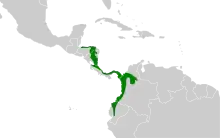Spotted antbird
The spotted antbird (Hylophylax naevioides) is a species of bird in the family Thamnophilidae. In southern Central America, it is found in Honduras, Nicaragua, Costa Rica and Panama; also Colombia and Ecuador of northwestern South America. Its natural habitat is subtropical or tropical moist lowland forests.
| Spotted antbird | |
|---|---|
 | |
| Scientific classification | |
| Kingdom: | Animalia |
| Phylum: | Chordata |
| Class: | Aves |
| Order: | Passeriformes |
| Family: | Thamnophilidae |
| Genus: | Hylophylax |
| Species: | H. naevioides |
| Binomial name | |
| Hylophylax naevioides (Lafresnaye, 1847) | |
 | |
Description


A smallish bird, measuring 11 cm (4.3 in) and weighing 16–19.5 g (0.56–0.69 oz). The male spotted antbird's plumage is a distinctive combination of a necklace of large black spots on a white chest, chestnut back, grey head, and black throat. The female is a duller version of the male, but also distinctive with large chest spots and two wide buffy wing-bars.[2]
Distribution and habitat
Forages as individuals or pairs in lower levels of mature, humid forests. Found in lowlands and foothills up to 1,000 m (3,300 ft).[2][3]
Behaviour
Spotted antbirds are known to follow army ant swarms to catch insects and other small animals trying to flee. They eat spiders, scorpions, cockroaches, katydids, crickets, centipedes, sowbugs, moths, beetles, caterpillars, ants, bristletails and, on occasion, lizards and frogs.
This bird is an open-cup nesting species that lays an average clutch of 2 maroon-splotched white eggs,[4][5] which both adults incubate.[6] The nestling period is 11 days.[4][6]
References
- BirdLife International (2012). "Hylophylax naevioides". IUCN Red List of Threatened Species. 2012. Retrieved 26 November 2013.CS1 maint: ref=harv (link)
- Angehr, George R.; Dean, Robert (2010). The Birds of Panama: A Field Guide. Zona Tropical. pp. 214–215. ISBN 978-0-8014-7674-7.
- Garrigues, Richard; Dean, Robert (2007). The Birds of Costa Rica: A Field Guide. Zona Tropical. pp. 180–181. ISBN 978-0-8014-7373-9.
- Skutch, Alexander F. (1945). "Incubation and nestling periods of Central American birds" (PDF). The Auk. 62 (1): 8–37. doi:10.2307/4079958.
- "Life History - Spotted Antbird". Neotropical Birds Online. The Cornell Lab of Ornithology, Cornell University. Retrieved 6 March 2014.
- Skutch, Alexander F. (1969). "Spotted antbird" (PDF). Life Histories of Central American Birds III: Families Cotingidae, Pipridae, Formicariidae, Furnariidae, Dendrocolaptidae, and Picidae. Pacific Coast Avifauna, Number 35. Berkeley, California: Cooper Ornithological Society. pp. 245–247.
Further reading
Styrsky, J.N.; Brawn, J.D. (2011). "Annual fecundity of a Neotropical bird during years of high and low rainfall". Condor. 11 (1): 194–199. doi:10.1525/cond.2011.100051.
- Willis, Edwin O. (1972). The Behavior of Spotted Antbirds (PDF). Onithological Monographs 10. Lawrence, Kansas: American Ornithologists' Union.
External links
| Wikimedia Commons has media related to Spotted antbird. |
| Wikispecies has information related to Hylophylax naevioides. |
- "Spotted antbird media". Internet Bird Collection.
- Spotted antbird photo gallery at VIREO (Drexel University)
- Spotted antbird species account at Neotropical Birds (Cornell Lab of Ornithology)
- Interactive range map of Hylophylax naevioides at IUCN Red List maps
